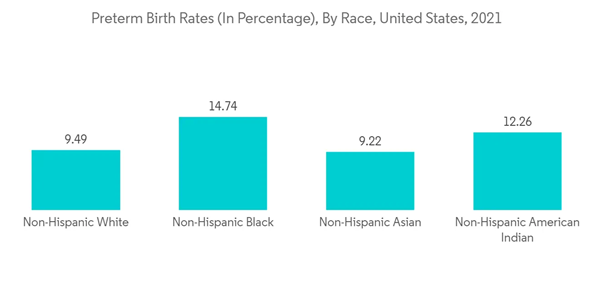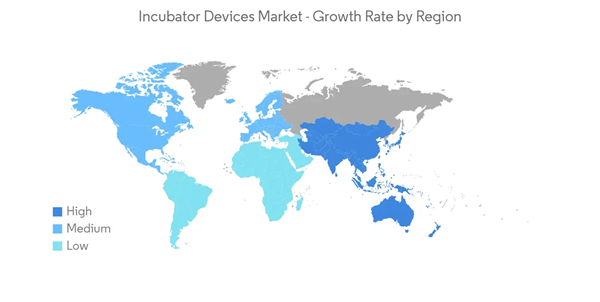The incubator devices market is expected to register a CAGR of 6.9% during the forecast period.
COVID-19 significantly impacted the market's growth as the adverse effects caused by COVID-19 and the increase in preterm births drove the demand for incubator devices. As per the article published by JAMA in August 2021, women with COVID-19 were more likely to have preterm birth compared to women without COVID-19. Such risks of preterm birth during the pandemic are expected to drive the market's growth. The increasing demand for incubators during the pandemic period was most likely due to the preservation of test samples for COVID-19. According to the Division of Cambridge Innovation Institute data published in May 2021, recognizing the need for COVID-19 PCR test samples, high-end microbiology incubators provide the precise temperature control necessary for effective heat activation and incorporate advanced design features that enhance laboratory safety and usability. Such benefits offered by incubators contributed to the growth of the market during the pandemic period. However, there were already a large number of incubators acquired by end users, such as hospitals, laboratories, and others, during the pandemic period. Hence, it is expected to have a slight decrease in demand for incubators post-pandemic. Furthermore, the demand for incubators is expected to grow in the coming years and is expected to reach pre-pandemic levels in the next five years.
Certain factors driving the incubator devices market growth include the rising prevalence of premature babies, low birth weight of babies, and growing R&D in healthcare.
In the past decade, the rise in the prevalence of premature babies increased the demand for incubators in the market. According to the CDC report published in May 2022, the preterm birth rate in the United States was 10.48% in 2021. Such incidences of preterm births are expected to drive the demand for incubator devices, thereby contributing to market growth during the forecast period.
Also, increasing product launches are expected to contribute to market growth. For instance, in August 2021, Thermo Fisher Scientific launched a CO2 incubator that combines optimal cell growth capabilities with certified cleanroom capability, addressing the growing need for biotechnology.
Thus, the above-mentioned factors are expected to contribute to the market growth during the forecast period. However, the lack of awareness in emerging economies and the high cost of incubators are expected to restrain the market growth during the forecast period.
Additionally, innovative product launches are expected to boost the growth of the studied segment during the forecast period. Also, in September 2021, Swiss architect Fabien Roy designed Robust Nest, an incubator for hospitals in Sub-Saharan Africa that functions through power cuts and was useful for preventing mortality due to hypothermia.
Thus the above-mentioned factors are expected to drive market growth during the forecast period.
Additionally, the high healthcare expenditure in the United States is expected to contribute to market growth. According to the data published by the United States Centers for Medicare and Medicaid Services in 2021, United States healthcare spending grew by 9.7% in 2020, reaching USD 4.1 trillion. Such high healthcare spending is expected to contribute to the growth of the market during the forecast period.
Also, the incidence of preterm births in Canada is expected to drive the demand for incubator devices. According to the NCBI article published in August 2021, the mean preterm birth rate for the study cohort was 7.96%. The report also mentioned that from January to December 2020, the preterm birth rate in Ontario was 7.87%. Such an incidence of preterm birth rates in Canada is expected to drive the growth of the market in this region.
Furthermore, the increasing number of product launches is expected to drive the market's growth. For instance, in August 2021, the Baker company launched ReCO2evr, a new rapid recovery cell culture that will bring even more value to its customers in the field of microbiology, cell culture, and biological safety.
Thus the above-mentioned factors are expected to drive the growth of the market during the forecast period.
This product will be delivered within 2 business days.
COVID-19 significantly impacted the market's growth as the adverse effects caused by COVID-19 and the increase in preterm births drove the demand for incubator devices. As per the article published by JAMA in August 2021, women with COVID-19 were more likely to have preterm birth compared to women without COVID-19. Such risks of preterm birth during the pandemic are expected to drive the market's growth. The increasing demand for incubators during the pandemic period was most likely due to the preservation of test samples for COVID-19. According to the Division of Cambridge Innovation Institute data published in May 2021, recognizing the need for COVID-19 PCR test samples, high-end microbiology incubators provide the precise temperature control necessary for effective heat activation and incorporate advanced design features that enhance laboratory safety and usability. Such benefits offered by incubators contributed to the growth of the market during the pandemic period. However, there were already a large number of incubators acquired by end users, such as hospitals, laboratories, and others, during the pandemic period. Hence, it is expected to have a slight decrease in demand for incubators post-pandemic. Furthermore, the demand for incubators is expected to grow in the coming years and is expected to reach pre-pandemic levels in the next five years.
Certain factors driving the incubator devices market growth include the rising prevalence of premature babies, low birth weight of babies, and growing R&D in healthcare.
In the past decade, the rise in the prevalence of premature babies increased the demand for incubators in the market. According to the CDC report published in May 2022, the preterm birth rate in the United States was 10.48% in 2021. Such incidences of preterm births are expected to drive the demand for incubator devices, thereby contributing to market growth during the forecast period.
Also, increasing product launches are expected to contribute to market growth. For instance, in August 2021, Thermo Fisher Scientific launched a CO2 incubator that combines optimal cell growth capabilities with certified cleanroom capability, addressing the growing need for biotechnology.
Thus, the above-mentioned factors are expected to contribute to the market growth during the forecast period. However, the lack of awareness in emerging economies and the high cost of incubators are expected to restrain the market growth during the forecast period.
Incubator Devices Market Trends
The Hospitals and Birthing Centers Segment is Expected to Witness a Healthy Growth Over the Forecast Period
An incubator is most commonly used in pediatric hospitals, birthing centers, and neonatal intensive care units. Hospitals are considered major end users by the manufacturers of incubators for selling their products since they help build brand image and expand their product reach. The increasing government focus on reducing infant mortality and morbidity rates has also led hospitals to concentrate on increasing their productivity. This is done by adopting advanced and innovative medical devices, including neonatal incubators. For instance, in August 2021, the National Health Mission, India, launched reproductive, maternal, newborn child, and adolescent health (RMNCH +A) to reduce the infant mortality rate to 23% by 2025.Additionally, innovative product launches are expected to boost the growth of the studied segment during the forecast period. Also, in September 2021, Swiss architect Fabien Roy designed Robust Nest, an incubator for hospitals in Sub-Saharan Africa that functions through power cuts and was useful for preventing mortality due to hypothermia.
Thus the above-mentioned factors are expected to drive market growth during the forecast period.
North America Dominates the Market and is Expected to do the Same Over the Forecast Period
The growing number of preterm babies, well-developed healthcare infrastructure, the presence of key manufacturers, and the availability of advanced technologies are factors contributing to the growth of the incubator devices market in North America. According to the CDC update in 2022, preterm births affected about one out of every 10 infants in the United States in 2021. This indicates the high number of preterm births in the country, which ultimately increases the demand for incubator devices.Additionally, the high healthcare expenditure in the United States is expected to contribute to market growth. According to the data published by the United States Centers for Medicare and Medicaid Services in 2021, United States healthcare spending grew by 9.7% in 2020, reaching USD 4.1 trillion. Such high healthcare spending is expected to contribute to the growth of the market during the forecast period.
Also, the incidence of preterm births in Canada is expected to drive the demand for incubator devices. According to the NCBI article published in August 2021, the mean preterm birth rate for the study cohort was 7.96%. The report also mentioned that from January to December 2020, the preterm birth rate in Ontario was 7.87%. Such an incidence of preterm birth rates in Canada is expected to drive the growth of the market in this region.
Furthermore, the increasing number of product launches is expected to drive the market's growth. For instance, in August 2021, the Baker company launched ReCO2evr, a new rapid recovery cell culture that will bring even more value to its customers in the field of microbiology, cell culture, and biological safety.
Thus the above-mentioned factors are expected to drive the growth of the market during the forecast period.
Incubator Devices Market Competitor Analysis
The incubator devices market is moderately competitive and consists of a few major players. Companies like Andreas Hettich GmbH & Co. KG, Atom Medical Corporation, BMT Medical Technology SRO, Drägerwerk AG & Co. KGaA, GE Healthcare, Medhold Medical (PTY) Ltd, Phoenix Medical Systems (P) Ltd, and Thermo Fisher Scientific Inc., among others, hold the substantial market share in the incubator devices market.Additional benefits of purchasing the report:
- The market estimate (ME) sheet in Excel format
- 3 months of analyst support
This product will be delivered within 2 business days.
Table of Contents
1 INTRODUCTION
4 MARKET DYNAMICS
5 MARKET SEGMENTATION (Market Size by Value - USD million)
6 COMPETITIVE LANDSCAPE
Companies Mentioned (Partial List)
A selection of companies mentioned in this report includes, but is not limited to:
- Andreas Hettich GmbH & Co. KG
- Atom Medical Corporation
- BMT Medical Technology sro
- Dragerwerk AG & Co. KGaA
- GE Healthcare
- Medhold Medical (PTY) Ltd
- Archimed (Natus Medical Incorporated)
- PHC Corporation
- Phoenix Medical Systems (P) Ltd
- Thermo Fisher Scientific Inc.
- Ningbo David Medical Device Co., Ltd
- Zhengzhou Dison Instrument and Meter Co. Ltd
Methodology

LOADING...










